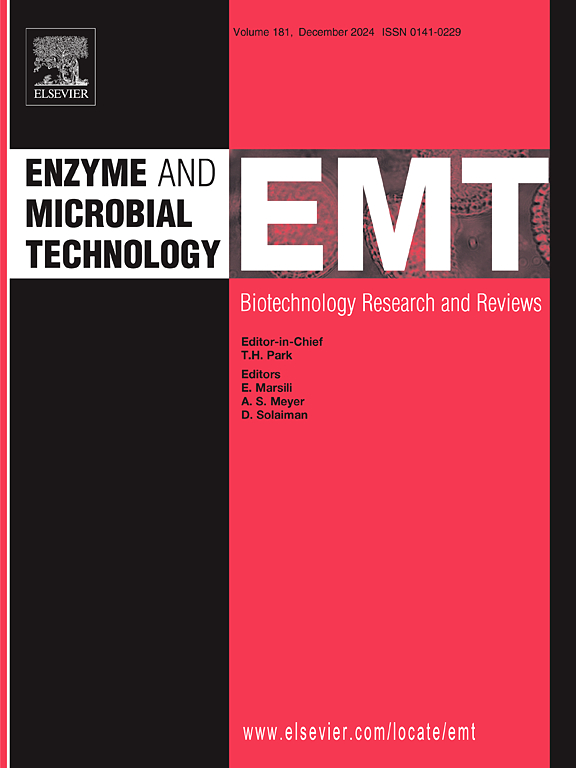In-vitro optimization and active-site mutagenesis of CYP105D18 peroxygenase enhance the production of indigo
IF 3.4
3区 生物学
Q2 BIOTECHNOLOGY & APPLIED MICROBIOLOGY
引用次数: 0
Abstract
Practical implementation of efficient biocatalysts for large-scale production of indigo remains challenging. Microbial cytochrome P450s may be useful for indigo production, but this has been rarely reported. We discovered that CYP105D18 catalysed H2O2-mediated C-3 hydroxylation of indole to synthesize indigo. A cell-free lysate from Escherichia coli containing CYP105D18 peroxygenase obtained after cell disruption was optimized for in vitro reaction. Next, 250 µM hydroxylamine was added to the cell-free lysate to inhibit other H2O2-utilizing enzymes that interfere with the CYP105D18 function. Furthermore, the active-site residues of CYP105D18, namely L87, A235, A282, and I386, involved in indole binding were mutated. L87F resulted in an approximately 12-fold increase in CYP105D18 activity. The catalytic efficiencies of the wild-type and L87F mutant were 0.01 and 0.12 mM−1min−1, respectively. Fed-batch fermentation using enriched autoinduction medium was used for higher production of E. coli cells containing CYP105D18 peroxygenase. The Cell-free lysate of disrupted cells yielded 710 mg/L of indigo in 20 min. This represents a simple enzymatic approach for indigo biosynthesis using cell-free lysate of E. coli overexpressing CYP105D18, H2O2, and catalase inhibitor without the need for multi enzyme systems and expensive cofactors. This single-enzyme system, used in a rapid process for indigo formation, could serve as an efficient approach for commercial bio-indigo production.
CYP105D18过氧酶的体外优化和活性位点诱变提高了靛蓝的产量
大规模生产靛蓝的高效生物催化剂的实际实施仍然具有挑战性。微生物细胞色素p450可能对靛蓝生产有用,但这很少报道。我们发现CYP105D18可以催化h2o2介导的吲哚C-3羟基化反应合成靛蓝。对细胞破坏后获得的含CYP105D18过氧酶的无细胞大肠杆菌裂解物进行了体外反应优化。接下来,在无细胞裂解液中加入250 µM羟胺,抑制其他干扰CYP105D18功能的利用h2o2的酶。此外,CYP105D18参与吲哚结合的活性位点残基L87、A235、A282和I386发生突变。L87F导致CYP105D18活性增加约12倍。野生型和L87F突变体的催化效率分别为0.01和0.12 mM−1min−1。利用强化自诱导培养基进行补料分批发酵,以提高含有CYP105D18过氧酶的大肠杆菌细胞的产量。破坏细胞的无细胞裂解液在20 min内产生710 mg/L靛蓝。这代表了一种简单的酶促靛蓝生物合成方法,使用过表达CYP105D18、H2O2和过氧化氢酶抑制剂的大肠杆菌的无细胞裂解物,而不需要多酶系统和昂贵的辅助因子。该单酶系统用于靛蓝快速生成过程,可作为商业生物靛蓝生产的有效途径。
本文章由计算机程序翻译,如有差异,请以英文原文为准。
求助全文
约1分钟内获得全文
求助全文
来源期刊

Enzyme and Microbial Technology
生物-生物工程与应用微生物
CiteScore
7.60
自引率
5.90%
发文量
142
审稿时长
38 days
期刊介绍:
Enzyme and Microbial Technology is an international, peer-reviewed journal publishing original research and reviews, of biotechnological significance and novelty, on basic and applied aspects of the science and technology of processes involving the use of enzymes, micro-organisms, animal cells and plant cells.
We especially encourage submissions on:
Biocatalysis and the use of Directed Evolution in Synthetic Biology and Biotechnology
Biotechnological Production of New Bioactive Molecules, Biomaterials, Biopharmaceuticals, and Biofuels
New Imaging Techniques and Biosensors, especially as applicable to Healthcare and Systems Biology
New Biotechnological Approaches in Genomics, Proteomics and Metabolomics
Metabolic Engineering, Biomolecular Engineering and Nanobiotechnology
Manuscripts which report isolation, purification, immobilization or utilization of organisms or enzymes which are already well-described in the literature are not suitable for publication in EMT, unless their primary purpose is to report significant new findings or approaches which are of broad biotechnological importance. Similarly, manuscripts which report optimization studies on well-established processes are inappropriate. EMT does not accept papers dealing with mathematical modeling unless they report significant, new experimental data.
 求助内容:
求助内容: 应助结果提醒方式:
应助结果提醒方式:


